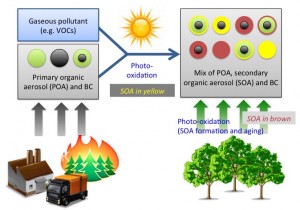1. Sources and Formation of Atmospheric Organic Aerosol
We conduct ambient measurements of particulate matter using a soot-particle aerosol mass spectrometer (SP-AMS) in Singapore to investigate sources and formation pathways of atmospheric organic aerosol. Singapore is a land-scarce and densely populated country located in a coastal region close to Southeast Asia rainforests, providing a unique opportunity to investigate individual and mixed influences of anthropogenic (e.g. ship, vehicle, forest fires and industry) and natural (marine and forest) emissions to air quality. The interactions in regions of this type with such complexity have not been nearly as well studied as other regions such as North America and Europe. This work is done in collaboration with Prof. Liya Yu (National University of Singapore, Civil and Environmental Engineering).
2. Mixing State of Carbonaceous Aerosol in Urban Environments
Understanding the mixing state of black carbon (BC) and the characteristics of its associated coatings are important to evaluate the fate and impacts of ambient BC. Organic coatings can be formed on BC surfaces by condensation of co-emitted primary organic aerosol (POA) near emission sources and secondary organic aerosol (SOA) during transport, modifying their optical properties and cloud formation potential. Our initial focus is to investigate the mixing state of carbonaceous aerosol (i.e., BC, POA & SOA) in an urban environment of Singapore by deploying a state-of-the-art soot-particle aerosol mass spectrometer (SP-AMS) with a single particle detection capability. Of particular interest is to understand the effects of atmospheric chemistry and regional transports of air pollutants on the mixing state of carbonaceous aerosol.

3. Chemistry of Atmospheric Brown Carbon (BrC)
Organic aerosol components that absorb solar radiation from near-UV to visible range can play an important role in radiative balance of the Earth’s atmosphere and hydrological cycle. This absorbing fraction of organic aerosol has been referred to as atmospheric brown carbon (BrC). BrC significantly alters the traditional view that organic aerosol interact with solar radiation via scattering only. We are particularly interested in atmospheric BrC formation and decomposition through aqueous-phase processing (e.g. wet aerosol and cloud chemistry) and in biomass burning emissions during transport.
